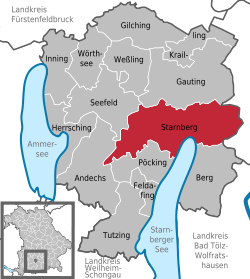Starnberg
| Starnberg | ||
|---|---|---|
| ||
 Starnberg | ||
Location of Starnberg within Starnberg district  | ||
| Coordinates: 47°59′50″N 11°20′26″E / 47.99722°N 11.34056°ECoordinates: 47°59′50″N 11°20′26″E / 47.99722°N 11.34056°E | ||
| Country | Germany | |
| State | Bavaria | |
| Admin. region | Oberbayern | |
| District | Starnberg | |
| Government | ||
| • Mayor | Ferdinand Pfaffinger (FW) | |
| Area | ||
| • Total | 61.77 km2 (23.85 sq mi) | |
| Population (2013-12-31)[1] | ||
| • Total | 22,650 | |
| • Density | 370/km2 (950/sq mi) | |
| Time zone | CET/CEST (UTC+1/+2) | |
| Postal codes | 82319 | |
| Dialling codes | 08151 | |
| Vehicle registration | STA | |
| Website | www.starnberg.de | |
The city of Starnberg is in Bavaria, Germany, some 30 kilometres (19 mi) south-west of Munich. It lies at the north end of Lake Starnberg, in the heart of the "Five Lakes Country",[2] and serves as capital of the district of Starnberg. Recording a disposable per-capita income of €26,120 in 2007, Starnberg regained its status as the wealthiest town in Germany from the Frankfurt suburb of Hochtaunus.

Residential area in Starnberg
History
The town was first mentioned in 1226 under the name of Aheim am Würmsee.[3]
Transport
Starnberg is situated on the Munich S-Bahn line S6, which provides frequent trains to and from Munich. It is also a principal stop for the vessels of the Bayerische Seenschifffahrt or lake fleet.[4]
Main sights
- Starnberger Schloss (castle) with the castle garden
- St. Joseph's Church
People associated with Starnberg
- King Ludwig II of Bavaria mysteriously drowned in Lake Starnberg at the small town of Berg nearby, on the evening of 13 June 1886.
- Oskar Maria Graf, the socially conscious writer, was born in Aufkirchen near Starnberg in 1894. He fought for the Bavarian Soviet Republic (or Räterepublik) in Munich in 1919. He fled his homeland in 1938 with his Jewish wife for the U.S.A., when National Socialism gripped Germany. Graf was never fully able to adjust to life in the United States or, more to the point, away from his homeland, Bavaria.
- The Austrian writer Gustav Meyrink was a resident of Starnberg from 1911 until his death in 1932 and is buried in the local cemetery.
- The philosopher and sociologist Jürgen Habermas has long lived and worked in Starnberg as a director of the "Max-Planck-Institut zur Erforschung der Lebensbedingungen der wissenschaftlich-technischen Welt".
- The Frankfurt School philosopher Herbert Marcuse died in Starnberg.
- Formula One driver Adrian Sutil was born in Starnberg.
- Multiple IMO (International Mathematical Olympiad) gold medalist winner, Christian Reiher was born in Starnberg.
- The St Olaves and Newstead Woods exchange students of 2009, who introduced the first cases of swine flu (Schweinegrippe) to Germany on 14 July 2009.
- SS General Karl Wolff lived in Starnberg after the war.
- The long-lived actor Johannes Heesters lived in Starnberg until his death.
- Actress Marianne Sägebrecht (Bagdad Café and other films) was born in Starnberg.
- German baritone Dietrich Fischer-Dieskau had his home there, where he died.
Notes
- ↑ "Fortschreibung des Bevölkerungsstandes". Bayerisches Landesamt für Statistik und Datenverarbeitung (in German). 31 December 2013.
- ↑ German: Fünf Seen Land: the lakes are the Starnberger See, the Ammersee, the Wörthsee, the Pilsensee and the Wesslinger See
- ↑ until 1962 the name of Lake Starnberg
- ↑ "Bayerische Seenschifffahrt" (in German and English). Bayerische Seenschifffahrt. Retrieved 2011-07-11.
External links
- Starnberg information
- Starnberger See - Lake Starnberg
- Starnberg official website
- Five Lakes Country tourist information
- Pictures of Starnberg
| ||||||||
